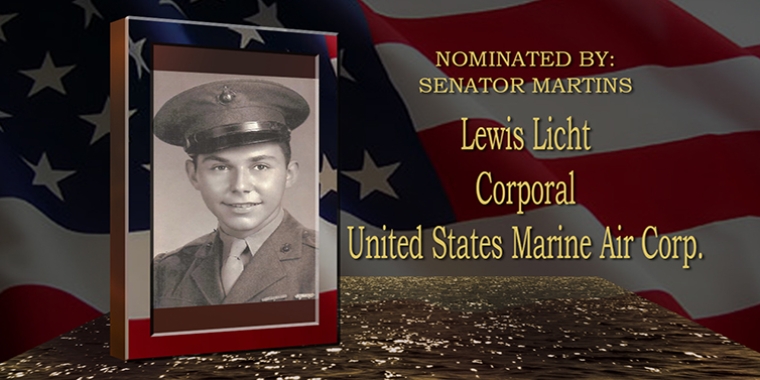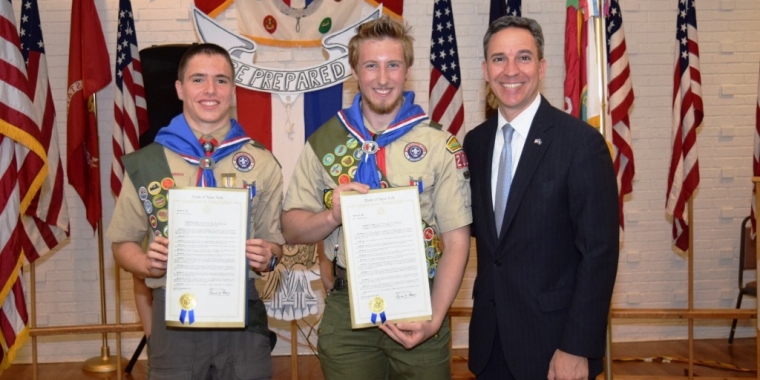
Tax Free Shopping Is Back In New York State
Jack M. Martins
September 2, 2011
As Long Island families continue preparing to head back to school this fall, Senator Jack Martins wants to make sure that all consumers know that clothing and footwear purchases under $55 per item are again exempt from the New York State portion of sales tax.
The 4% state portion of the sales tax was eliminated in an effort to help consumers save money while bringing in additional revenue to stores throughout the state. In addition, the 3/8% MTA portion of the sales tax was also eliminated for the areas affected, which includes both Suffolk and Nassau Counties.
According to a memo released by New York State Department of Taxation and Finance, the exemption applies to sales of clothing and footwear worn by humans which sells for less than $55 per item (or per pair in the case of footwear). The NYSDTF also specified that the exemption also applies to most fabric, thread, yarn, buttons, snaps, hooks, zippers, and similar items that become a physical component part of exempt clothing or that are used to make or repair exempt clothing.
Due to the fact that both Nassau and Suffolk County have so far decided against providing a local exemption, sales in both counties will still be subject to county tax of 4¼%.
Additional Information From The New York State Department Of Taxation And Finance
Transitional provisions relating to clothing and footwear sales
Orders for clothing, footwear, and items used to make or repair clothing
Merchandise that is ordered by mail, telephone, the Internet, or e-mail, is taxed at the rate in effect on the date the order is accepted by the vendor regardless of when the order will be delivered. An order is accepted by the vendor when the vendor has taken an action to fill the order. Actions to fill an order include placing an in-date stamp on a mail order or assigning an order number to a telephone order. For orders accepted on or after April 1, 2011, the exemption in effect on the date the order is accepted will apply.
Rain checks
Any purchase made with a rain check is taxed based on the sales and use tax in effect at the time of the purchase, without regard to when the rain check was issued. The exemption in effect at the time of purchase will apply.
Layaway sales
A layaway sale is a sale in which merchandise is set aside for future delivery to a customer who makes a deposit and agrees to pay the balance of the purchase price over a period of time before the merchandise is delivered. The sales price of the merchandise includes any additional charges a vendor makes for putting the merchandise on layaway. If a vendor and a customer enter into a contract for a layaway sale of eligible clothing or footwear on or after April 1, 2011, the exemption in effect will apply as long as the customer makes a deposit of at least 10% of the purchase price and the merchandise is segregated from other inventory.
Returns and exchanges
If a customer purchases eligible clothing or footwear before April 1, 2011, and pays tax on the purchase, and then returns the item and receives a store credit or is allowed to purchase an exempt item on or after April 1, 2011, through March 31, 2012, the tax paid on the purchase of the initial item can be refunded or credited. This is because the original sale was canceled. If a customer purchases exempt clothing or footwear on or after April 1, 2011, and later returns the item for an exchange, there will be no tax due as long as the item is exchanged for another exempt item (i.e., an item of clothing eligible for the less-than-$55 exemption is exchanged for another item eligible for that exemption, or an item of clothing eligible for the less-than-$110 exemption is exchanged for another item eligible for that exemption). If the customer returns the original item and receives a credit or is allowed to purchase a different item that is not eligible for the exemption, the applicable sales tax will apply to the sale of the newly purchased item. For example, if a customer buys a pair of shoes and returns them for store credit, and then uses the credit to purchase an umbrella, tax is due on the full price of the umbrella.
Description of the clothing and footwear exemption
The exemption applies only to clothing and footwear worn by humans. It also applies to most fabric, thread, yarn, buttons, snaps, hooks, zippers, and like items which become a physical component part of exempt clothing or that are used to make or repair exempt clothing. While the exemption applies to items of clothing and footwear worn on the body, not all items worn on the body qualify as clothing or footwear. Jewelry, watches, and like items remain taxable. Equipment items, such as tool belts, hard hats, and sport, bicycle and motorcycle helmets, though worn on the body, remain taxable. Protective goggles and safety glasses (unless prescription) for sport or occupational use, protective sport or occupational masks or pads, hockey and baseball fielders’ gloves or mitts, ice skates and roller skates, fireplace mittens, and similar pieces of equipment (sporting or otherwise) also remain taxable. Antique clothing and footwear are exempt if they are purchased for human wear and not as collector’s items. All purchases of doll and pet clothes and footwear are taxable. If exempt clothing or footwear is sold with other taxable merchandise as a single unit, the full price is subject to sales or use tax, unless the price of the clothing or footwear is separately stated. For example, a store has a boxed gift set for sale that has a French-cuff dress shirt, cufflinks and a tie tack. The gift set is sold for a single price of $50. Although the shirt sold by itself would be exempt, the full price of the boxed gift set would be taxable because the cufflinks and tie tack are taxable and the selling price of the shirt is not separately stated.
The following additional limitations will apply to the exemption.
- The article of clothing or pair of shoes or other articles of footwear must be sold for less than $110 per article or pair. This less than $110 limitation also applies to each item of fabric, thread, yarn, buttons, snaps, hooks, zippers, and like items which become a physical component part of exempt clothing or that are used to make or repair exempt clothing. A charge by the vendor for alterations to clothing sold by the vendor should be included when determining whether the less than $110 limitation has been met, unless the vendor separately states a reasonable charge for the alteration on the receipt given to the purchaser of the clothing [see TSB-M-02(4)S].
- Costumes and rented formal wear are not eligible for exemption. Nor does the exemption apply to fabric, thread, yarn, buttons, snaps, hooks, zippers, and like items which become a physical component part of costumes or rented formal wear or that are used to make or repair costumes or rented formal wear.
- Items of fabric, thread, yarn, buttons, snaps, hooks, zippers and like items used to make or repair otherwise exempt clothing are not eligible for exemption if the item is made from real or imitation pearls, or from real or imitation precious or semiprecious stones, jewels, or metals.
- Most accessories (such as handbags, umbrellas, watches, and watchbands) are not considered clothing and are taxable. However, belt buckles, handkerchiefs, sweatbands, head scarves, and neckwear, such as scarves and ties, are exempt.
- Fabric, thread, yarn, buttons, snaps, hooks, zippers, and like items used to make or repair taxable products are taxable.
- Monogramming of clothing prior to its sale is eligible for exemption if the monogramming is sold in conjunction with the sale of the clothing and the price for the monogrammed item is less than $110. However, if the monogramming is done separately by a vendor for a separate charge, the charge for this service is taxable. This limitation also applies to the application of decals, logos and like items (e.g., pictures or letters) by sewing, printing, imprinting, silk screening, and the like.
Delivery, shipping, and handling charges (delivery)
Reasonable, separately stated charges by the vendor for delivery of eligible clothing and footwear are not taken into account in determining if the cost of an item is less than the $110 limitation. For example, if an article of clothing sells for $95 and the vendor charges $20 for delivery, the clothing and the delivery charge qualify for exemption. However, delivery charges by the vendor for items or pairs costing $110 or more remain subject to tax.
Coupons
If a customer uses a manufacturer’s coupon to pay for an article of clothing or a pair of shoes or other articles of footwear, the value of the coupon does not reduce the selling price for purposes of determining whether the article or pair is sold for less than $110. But if a customer pays for clothing or footwear using a store coupon, for which the store receives no reimbursement, the store coupon does reduce the selling price of the clothing or footwear for purposes of determining whether the item is sold for less than $110.
Listing of Exempt and Taxable Items:
Aerobic clothing
Antique clothing (for wear)
Aprons
Arch supports* (unless rented)
Arm warmers
Athletic supporters
Athletic or sport uniforms or clothing (but not equipment such as mitts, helmets and pads)
Bandanas
Bathing caps
Bathing suits
Beach caps and coats
Belt buckles
Belts/suspenders
Bibs (baby)
Blouses
Boots (climbing, fishing, riding, ski, waders)
Bridal gowns and veils (unless rented)
Caps
Coats and wraps
Corset laces
Coveralls
Diapers (adult - including disposable)*
Diapers (children - including disposable)
Dress shields
Dresses
Ear muffs
Formal clothing (unless rented)
Fur clothing
Garters/garter belts
Girdles
Gloves (batting, bicycle, dress [unless rented], garden, golf, ski, tennis, work)
Graduation caps and gowns (unless rented)
Gym suits
Hand muffs
Handkerchiefs
Hats
Hosiery (panty hose, peds, etc.)
Insoles
Jeans
Jogging suits
Lab coats
Leg warmers
Leotards
Lingerie
Pajamas
Ponchos
Prom dress (unless rented)
Rain wear
Receiving blankets
Religious clothing
Rented uniforms (unless formal wear/costume)
Riding pants
Robes
Scarves
Scout uniforms
Shawls and wraps
Shirts
Shoes (ballet, bicycle, bowling, cleated, football, golf, jazz/dance, soccer, track, etc.)
Shoe inserts
Shoe laces
Shoulder pads, for dresses, jackets, etc. (but not athletic or sport protective pads)
Shower caps
Ski masks
Sleepwear
Slippers
Sneakers
Socks
Sports clothing and uniforms (but not equipment such as mitts, helmets and pads)
Stockings
Support hosiery
Suspenders
Sweat bands
Sweat suits
Ties/neckwear
Tights
Tuxedo (unless rented)
UnderwearUniforms (occupational, military, scouting, sport)
Wet and dry suits
Yard goods, and notions**
* Items marked with an asterisk are exempt regardless of their price.
** Yard goods and notions (fabric, thread, yarn, buttons, snaps, hooks, zippers and like items) used or consumed to make or repair exempt clothing which become a physical component part of the clothing are generally exempt.
Share this Article or Press Release
Newsroom
Go to NewsroomLewis Licht
May 20, 2016

